In September, President Obama traveled to Alaska and called on the U.S. to accelerate production of icebreakers for the Coast Guard. With that, what once was a little-known capability gap for the U.S. rocketed to the forefront, and has increased pressure on Congress to find a solution as Russian President Vladimir Putin builds up his defenses in the Arctic.
Adm. Paul Zukunft, Coast Guard commandant, sat down with the Washington Examiner to discuss Russia’s ambitions and the Coast Guard’s changing requirements and mission in the Arctic.
Washington Examiner: Many have said, especially following the president’s trip, that the U.S. is playing catch-up to other Arctic nations like Russia or China. Do you see the U.S. as playing a catch-up role, and what sort of national security threats does the U.S. face in the Arctic?
Zukunft: I think the president’s statement first of all acknowledges that we have equities in the Arctic and that we’re an Arctic nation. It’s an area that we quite honestly haven’t made any significant investment in nearly 20 years now. So you go back, what’s changed in 20 years? We’ve seen record levels of sea ice retreating further north and with that much more human activity than we’ve seen.
Quite honestly, we did not even envision 10 years ago that ships would be transiting the northern sea route, and now cruise ships next year taking passengers across the Northwest Passage because as that sea ice retreats, the water underneath it has not been charted to modern day standards. Less than 5 percent of the Arctic is charted to what we would say are 21st century standards. So you’ve got this one increase in human activity in a part of the ocean that we have a responsibility for.
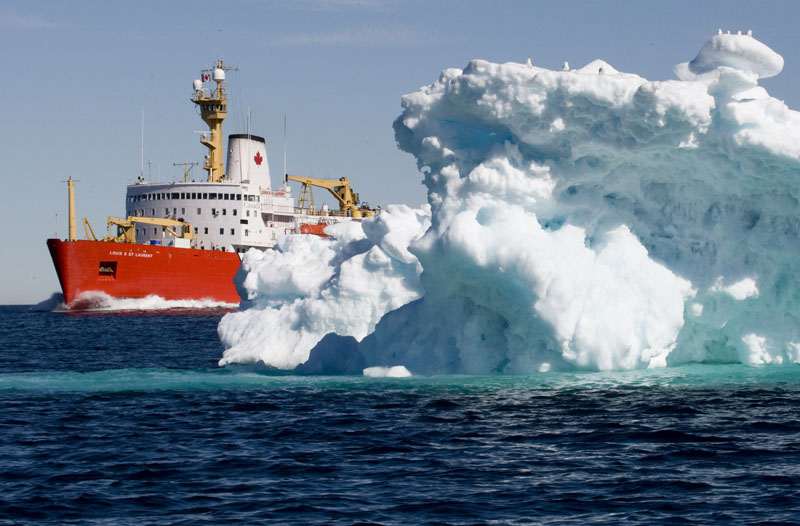
The Canadian Coast Guard icebreaker Louis S. St-Laurent. (AP Photo)
Now you’ve got these very rich oil and natural gas reserves up there, I was just up there, I just came back Sunday. I was on the Noble Discoverer who [is] by the Polar Pioneer working for Shell that is actually drilling and will actually drill into hydrocarbon this year. So now you’ve got this oil exploitation potential up there and there could be competition for access to this part of the world. Maybe not today but looking out into the future where roughly 13 percent of the world’s oil and it’s estimated about one-third of the world’s natural gas is up in the Arctic.
So could there be others who could try to encroach upon the sea bed, which is sovereign territory of ours.
One other piece of that is that there’s also military activity taking place up there with Russia. Russia has been less than transparent in terms of what their intent is in the Arctic, but they’re building installations under the auspices of search and rescue also with a military footprint there as well.
Examiner: I know the Russians are building the 14 air bases in the Arctic and just recently we saw the five Chinese ships in the Bering Sea. How worried are you about these things, and how worried should Congress be?
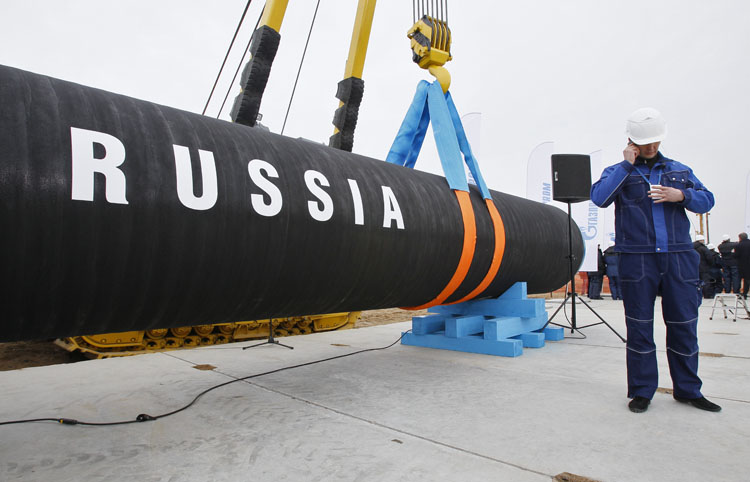
Portovaya Bay, located north-west of St. Petersburg, Russia, during a ceremony marking the start of Nord Stream pipeline construction. (AP Photo)
Zukunft: It’s a lack of transparency and we’ve already got a model of what that looks like in the East and South China Sea. Where you may have nations in the Arctic making assertions that they routinely operate up there as part of a global commons, but at the same time Russia is building up capability that may be intended to deny U.S. access into that domain and to extend their base of operations as an offensive force targeting against the U.S., using the Arctic as a base to carry out those operations.
So yes, I am concerned, just because of the complete lack of transparency in what we’ve seen taken place over the last several years in other parts of the world.
Examiner: The Navy is obviously dealing with the receding ice as well and the opening of the water. What sort of cooperation does the Coast Guard have with the Navy in the Arctic?
Zukunft: We send a national security cutter up there, and really not just for the Navy but really for the good of the entire intelligence community, so we’re providing domain awareness. It’s not just what’s on the water, but we can also monitor what’s in the air as well. While at the same time, we’re up there for environmental protection, safety of life at sea, so what’s unique about our national security cutters is they can be supporting three or four other service requirements at the same time.
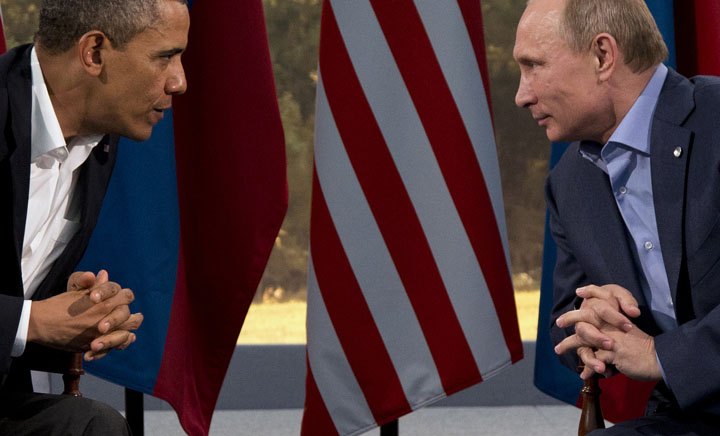
So we’re providing that level of support, but right now, I don’t see an emerging requirement for us to be sending naval combatants up into the Arctic domain. The Arctic Council has set forth some very good strategic objectives among the eight Arctic Council members, but recognizing their charter is not to address maritime security, so their focus has been very much environmental, indigenous tribes, safety of life at sea, so we’re creating an Arctic Coast Guard Forum.
We’ll stand up a meeting in October, next month, we expect to have all members of the Arctic Council nations at the table to develop a set of guidelines for what the roles of the coast guards are in the Arctic and really try to reshape this domain, not to make it a military domain, but very much an environmental, safety of life at sea, maybe a law enforcement component if there’s illegal fishing activity in the like, and not make it a military battlefield if you will. So that’s our focus, trying to reset our behavior toward the Arctic.
Examiner: Talking a little more about interagency and inter-department cooperation, I saw a hearing last year on the Hill where Congress basically said multiple agencies are all using these icebreakers, they should be contributing to the Coast Guard. Do you think the Navy and the National Science Foundation should be financially helping out if they’re going to be using these Coast Guard assets?
Zukunft: That will really start with, we first have the support of the White House. The statement that President Obama made is powerful. What it does do is it says this is important, we need to make it a priority. I think it then falls on [Office of Management and Budget] of where do you find the source to fund this? I fully expect that one place that will be looked at is the Navy’s shipbuilding budget. I just say that as an observer and not as an advocate, but I have an acquisition budget of just over $1 billion to buy everything, so clearly not in our base, but a base does need to be established.
Among many of the other members that have Arctic equities, National Science Foundation, Arctic Research Council, Department of Commerce, Department of Interior and others, it’s probably not within their base either to be able to support it. Is there another funding mechanism? Is it possible if we’re going to lease blocks of the ocean for oil and gas exploitation, do we take into consideration what it requires to have federal government presence to monitor that activity and might that be used as a down payment for some of the capital we need within our federal government inventory to carry out those operations?
The model that we already have is a surcharge on barrels of oil that support our oil spill liability trust fund so if there’s a spill, we don’t have a responsible party, we do have a federal reserve account but it’s all derived from a surcharge applied to the oil industry. So that might be another approach that could be considered as well.
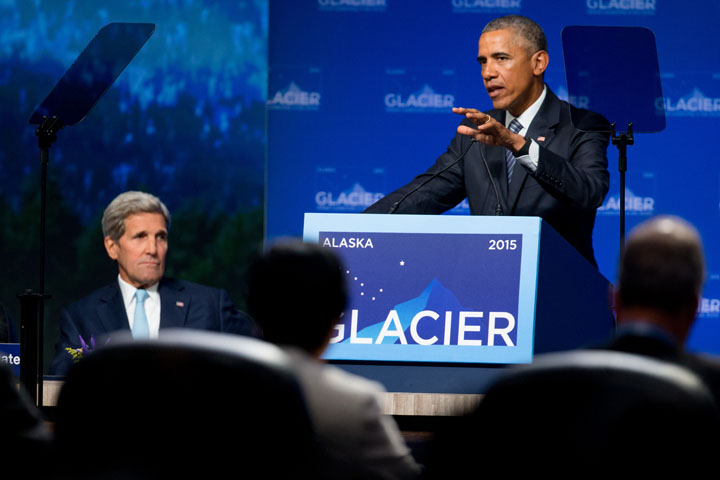
Examiner: Do you think that there’s a willingness on Capitol Hill now to actually take the threat seriously and look at these options you’ve laid out and actually fund this?
Zukunft: I’m probably the fourth commandant in succession that has been carrying this message to the Hill. Obviously, we answer to a number of committees and members change, but clearly the interest prior to this announcement that was made last year I would say has reached a fever pitch. There’s clearly a cause for action on the Hill. I think the biggest challenge is going to be where do we find the appropriation with a number of other challenges that are on the Hill as we speak, not the least of which is, do we have a budget going into 2016?
If you’re under a continuing resolution, that usually impedes your ability to start up a new acquisition, so I think the cause for action is clearly there, it’s the how piece and how do we fund this is the bigger challenge.
Examiner: I wanted to talk a little bit about international partners. Are there any countries with which the U.S. is partnering? Any areas where we could or should be doing more?
Zukunft: We have the Coast Guard cutter Healy, our medium icebreaker, they’re just coming down off the North Pole right now, but part of their ship’s company is 51 scientists, many of them come from the international community. While they were up there, they were providing research data that Germany was doing. The two ships actually met up at the North Pole to do a data exchange so what we don’t know within the international community, we’re sharing that internationally, I mean within the scientific community. So there’s been very good collaboration there to share that scientific data multilaterally.
This is really the impetus behind us standing up an Arctic Coast Guard forum, to have all eight Arctic Council nations working in concert with one another and realizing that this was first attempted several years ago by another country who did not invite Russia to the table. When Russia wasn’t invited, then most of the other Arctic Council nations had no interest in participating. They said if we can’t do this collaboratively as one Arctic Coast Guard Forum, then there’s no point in moving forward, recognizing that Russia has the most assets in the Arctic right now. So we’ll be able to bring Russia to the table in these discussions.
We had a preliminary meeting in this building back in March working through our State Department to be able to continue to have a dialogue on the Arctic with my counterparts from Russia rather than with our other causes for tensions with Russia to preclude any further conversation. This is one area that we’re still able to have meaningful dialogue as it pertains to the Arctic. I think that will be the big collaborative effort that we have as we look at maritime activity in the Arctic, not necessarily from navies, but from coast guards and to do it in a collaborative fashion.
Examiner: So you’re talking to your counterpart at the Russian Coast Guard?
Zukunft: This is Russia, Canada, Finland, Denmark, all of the Arctic Council nations.
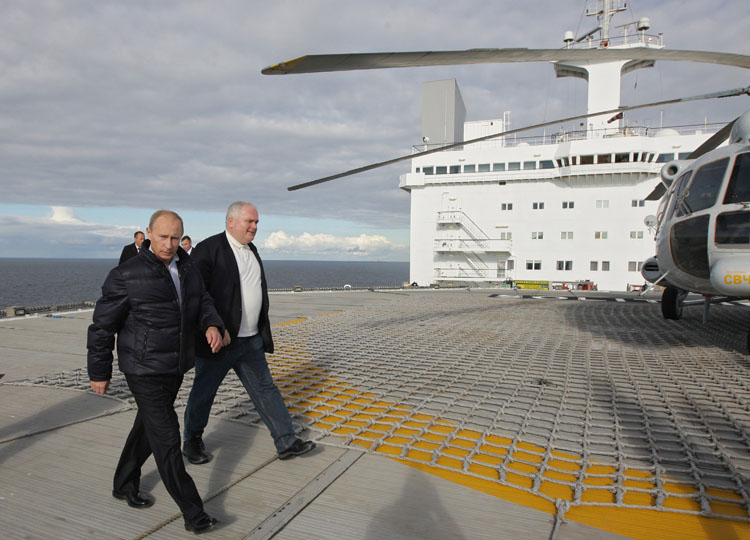
Examiner: This Arctic Coast Guard forum, this will be its first meeting in October?
Zukunft: This will actually be the first meeting of principles. So I’ll represent the United States. Ironically, this next week I’ll meet my counterpart from Russia in Seoul, South Korea, where we’re having a multilateral summit for our North Pacific Coast Guard Forum. The way that works is each year we send one of our Hamilton-class cutters, C-130s and the five other North Pacific Coast Guard Forum countries — Canada, Russia, Korea, China, Japan — we do a combined operation. Not an exercise, but it’s a bona fide operation going after illegal fishing.
We use all sources of information to ascertain where this illegal activity might take place. We have a Chinese ship rider on a Coast Guard cutter, which is a warship. We have Japan and Canada flying air surveillance. We fly surveillance flights out of Japan and, if we have an interdiction case, we typically hand it off to China for final prosecution. So we’re using that as a model to not just meet but actually deploy assets with a view of doing a mass rescue exercise in the Arctic hopefully within the next two years.
Examiner: The forum, the goal is to look at what the Coast Guard’s role should be there, worldwide. Is that accurate?
Zukunft: So what we’ll do is start with a combined set of guidelines. How do we coordinate a mass search-and-rescue event? How do you notify one country? How do ships communicate, airplanes communicate? What are staging areas that you might use? So it starts very broad-based, but then it really gets down to if you had a cruise ship with potential mass loss of life, how would you manage that particular response? Same thing with an oil spill. What other activity is taking place in the Arctic, what we call maritime domain awareness, and then really how do we share that information among all the stakeholders.
We have a mechanism in place right now for the North Pacific Coast Guard Forum, including the sharing of information, a dedicated database serve that does just that. So looking at if we can’t do the same thing for the Arctic.
Examiner: Getting back to the funding for the new icebreaker, what are your thoughts over this turning into a political fight over climate change and over the budget?

Russian ice breaker. (AP Image)
Zukunft: From the Coast Guard perspective, this is a mission that we’ve had for going on 50 years now and we have a longstanding mission to provide logistic support to the scientific mission down in McMurdo in Antarctica. That’s where the requirement for a heavy icebreaker really comes into play. In even the best of years, a medium icebreaker such as a Healy can’t carry out that mission, or if they did, there’s a good likelihood they could be set in ice and then we have no means to rescue it. It’s hard to predict in a linear fashion what is the Arctic going to look like 10, 15 years from now.
Are there wind shifts? Is there some other activity that would cause the Arctic to now see higher levels of freezing? You might say the course we’re on is irreversible. You also have the ring of fire and so what if you have a cataclysmic volcano that now causes several extreme winters and now we’ve got the Arctic where it was 15-20 years ago, but now you’ve got production platforms and what I would say national critical infrastructure up there. So it’s just hard to predict 10, 15 years out. But to do nothing about it, we recognize that we’re already probably about 10 years behind where we need to be.
We did refurbish the Polar Star. Our hope is that will buy us a 10-year window of time to bring another heavy icebreaker into our fleet mix. We’ve already consumed over two of those years, so that clock is still ticking. One course of action is to reactivate an even older ship, the Polar Sea, and we’re doing an assessment on that to see what would it take to reactivate it. So we’ll make that decision next year. So there’s always this cut to the chase, how much is it going to cost?
This is a ship that’s been laid up now for five years, parts were cannibalized in order to get the Polar Star running, it hasn’t had a crew on it for that same amount of time as well. So it’s like an old car that’s been laid up without an engine in it, an engine that’s been stripped of its parts. It’s not until you really tear into it, and what you maybe thought you could do for $100 million is now $200, is now $300, $400 and you reach a point where you keep throwing good money after bad. You step back and say, well if it was a car, you should’ve bought a new car instead.
The other part to look at with these old icebreakers is if they don’t meet today’s MARPOL code [a regulation to limit accidental or operational pollution from ships] for environmental compliance. If we are setting the standards, we the United State Coast Guard, ship-going standards to operate in the Arctic under that polar code, then by golly we ought to be in compliance as well and not in violation. So as we look at new construction, we want to make sure we’re in compliance with modern day environmental standards up there as well.
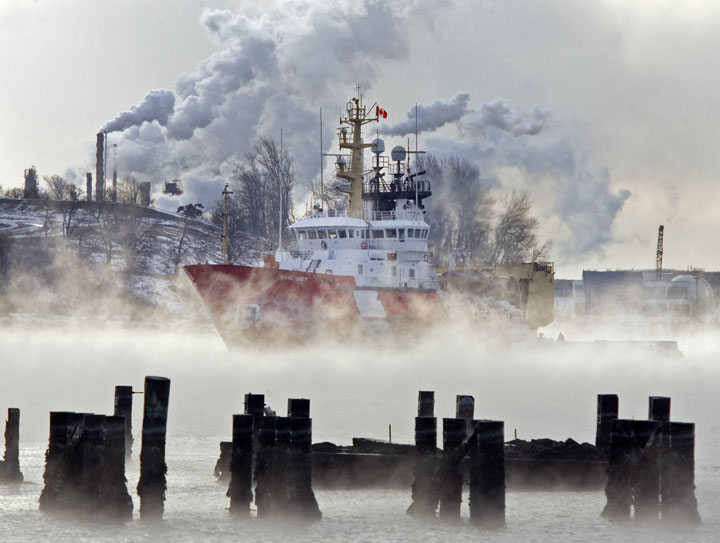
The Canadian Coast Guard icebreaker Earl Grey heads to dock in Dartmouth, Nova Scotia through Arctic sea smoke on Halifax Harbour. (AP Photo)
Examiner: Do you have any idea of costs for reactivating the Polar Sea?
Zukunft: That’s why we’re doing this full assessment, but we should know probably within a year from now, and what that will provide us is a floor. It will cost not less than, and I would never give an exact amount because it’s not until you tear into this with an old ship in trying to find new parts and the like, those costs in all likelihood will grow over time.
Examiner: What was the Arctic like this summer, and what sort of increase in traffic did you see?
Zukunft: The biggest increase we saw was the number of ships that Shell has brought up into the Arctic, all the support vessels because there’s no deepwater port up there. So you want to make sure you’ve got everything you need up there because the nearest deepwater port is 1,000 miles away. So they’ve got a fleet of over 20 ships up there right now. One of them is drilling, the Polar Pioneer. The other one, the Noble Discoverer, is on standby.
They’re on standby because if they have a loss of well control during the drilling on the Polar Pioneer, it’s the job of the other drilling unit, the Noble Discoverer, to come in and drill the relief well, just like we did with Deepwater Horizon. The big difference here is it’s in much, much shallower water. Deepwater Horizon, that was a mile deep. Here we’re talking water less than 200 feet deep, so relatively shallow when it comes to offshore drilling. Once the Polar Pioneer finishes with its part of the work, they do what they call a plug and abandon the hole that they’ve drilled, they can come back next year.
But once they do, then the Noble Discoverer will start drilling at another site, about nine miles away from where the Polar Pioneer is. But there’s a regulatory regime that prohibits the two ships from drilling within 15 miles of one another, so you’ve got two big drilling units up there, lots of folks, they’re on there for 28 days. Every 28 days, a new crew comes out, so you’ve got helicopters, a lot of human activity going back and forth. At the same time, you’ve got the north slope burrow and the indigenous tribes that live up there, they live off the water.
And a big part of their diet supplement is the bowhead whale, so we want to make sure that that activity doesn’t interfere with their ability to harvest marine mammals. Next year, there is a cruise ship that does plan to transit the Northwest Passage going from west to east, so getting back to modern day charting standards in the Arctic, what happens if there’s an event up there. Depending on what the feedback is from these cruise ship passengers and depending on what fare they pay, but apparently this is a once-in-a-lifetime experience.
This could lead to a proliferation of even more cruise ships wanting to take part in this once-in-a-lifetime experience as long as passengers are willing to pay their fare. So I look at what is the likelihood of something going back? It’s the more repetitions you have, so if you have more ships going through there, then the likelihood that one of them may stumble upon a pinnacle, an uncharted object.
You probably remember the Costa Concordia, right off the coast of Italy, but if you have an event like that, you are hundreds of miles, thousands of miles perhaps, away from any lifesaving station, be it U.S., Canada or a number of the other Arctic Council nations.
Examiner: The missions that the Coast Guard has — the oil spills, the search and rescue, the drug interdiction to some extent — you have them in the Arctic as well. What’s different about doing these missions so far from resources in such harsh conditions, and is the service prepared?
Zukunft: The biggest shortcoming in the Arctic is you don’t have the shore infrastructure. We don’t have those permanent bases that we operate from in the lower 48. We don’t have a hangar that we own. We’re leasing one in Deadhorse, Alaska. That’s not the optimal location. Barrow is much closer, but we have been outbid for that space, and we accept that we can’t outbid the major oil company for that space. So we’re operating two helicopters from there, but again, if you have an event that takes place in the Arctic, you don’t have a land-based command center. Your command center is actually in the fleet.
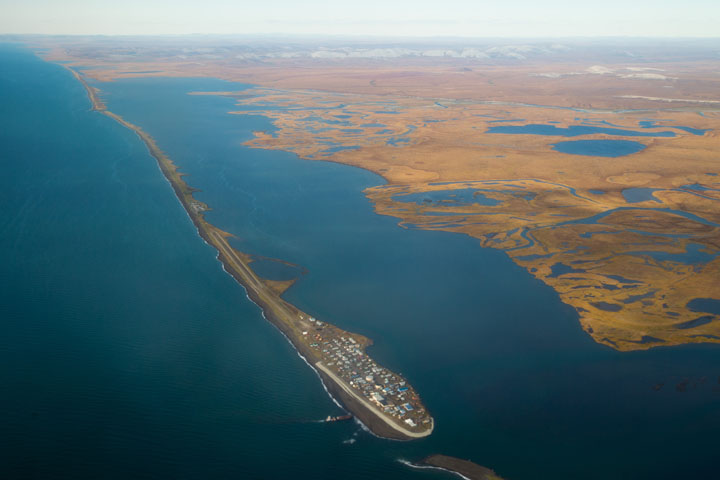
Island village of Kivalina, a native community in Kotzebue, Alaska. (AP Photo)
Which is why, in this case Shell has this armada of vessels up there as well because most of those operations are being orchestrated from the sea. So there’s a land component that does the dispatching work, but if there’s an event that takes place up there, it really needs to be coordinated from the sea, so that’s where our role is up there with the fleet-based, sea-based rather than land-based approach for command and control.
Examiner: So is the service ready? The fact that this cruise ship is going up there, should something happen, would the Coast Guard, together with international partners, be able to respond?
Zukunft: Will not be able to respond in a timely fashion. Because what we will not be able to do is escort that ship every mile of the way. So if there were to be a mishap, it may take us hours for a ship, maybe days, before we could be on scene. Think back to the Titanic. It took 90 minutes for the Carpathia to discover that the Titanic was sinking or had sunk. In that 90 minutes, 1,500 people died. So here, I can’t even get there in 90 minutes with a ship, so I think those are the risks.
The water temperature up there, sea water freezes at 28 degrees Fahrenheit. So maybe it’s open water, but that water isn’t much above 32 degrees Fahrenheit, so hypothermia would set in immediately. There is a great potential for a significant loss of life in the event of a mishap up there.
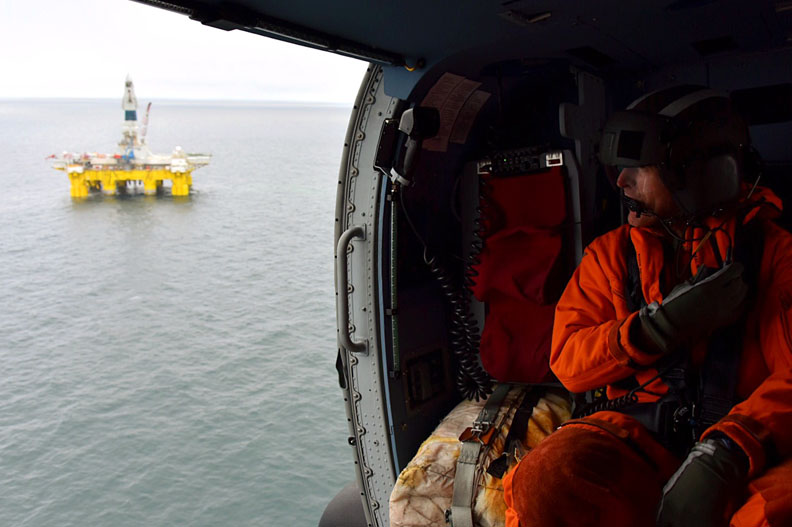
Adm. Paul Zukunft, Coast Guard commandant (U.S. Coast Guard)
Examiner: Did they have to check with the Coast Guard before the cruise ship planned the trip?
Zukunft: No, they’re on an international voyage through an international strait.
Examiner: Getting back to this summer and the increase in traffic you saw, obviously the Coast Guard budget is just as tight as the rest of the government. Did you have to pull services from any other places to be able to properly attend to the increase in traffic?
Zukunft: We did pull one ship, one of our national security cutters who had other tasking, but this was of such a priority that this became our higher priority to have them up in the Arctic, because it’s the one asset we have that can sustain some meaningful degree of presence up there during the ice-free season, but it’s strictly on a seasonal basis. When I was up there, again just this past weekend, there was no ice within 150 miles of Barrow, Alaska.
When I met with the mayor of the North Slope burrow up there in Barrow the week before, they had a pretty severe storm that inundated the coastline, a lot of coastal erosion and almost had sea water intrusion into their only freshwater reservoir. So when you talk to people up there as the sea ice retreats, this is having a very significant impact on the people who live up there, nearly 4,000 permanent residents who live in Barrow, Alaska.
Examiner: Where was that national security cutter supposed to be?
Zukunft: We would have sent them into the counter-drug environment.
Examiner: Anything else I didn’t ask you about that you’d like to add?
Zukunft: The biggest piece in all of this is we have a standing commitment and ideally, let’s take the politics out of all of this. We’re an Arctic nation for the long run. And this is more than a passing fad that we’re seeing right now. There are other major oil companies that have keen interest, but this just isn’t about oil and gas. This is about people whose way of life may be significantly altered with an increase in activity in the Arctic, and what happens to ground fish, do they now migrate to the Artic as well?
So now we have fishing fleets, even though there’s a moratorium up there, is a paper order going to convince an international fishing fleet not to go there? So I think those are all the other aspects that we’re looking at of what can change in the next five, 10, 15 years, but recognizing it takes years to build a new icebreaker, years to build out a fleet. So we’ve incorporated that into our Arctic strategy as we look at not just present day, but looking out into the future as well.
